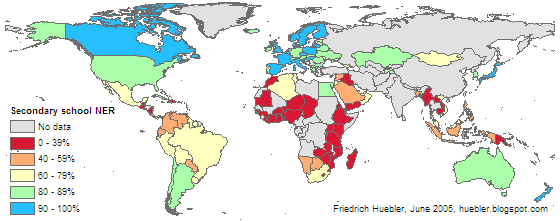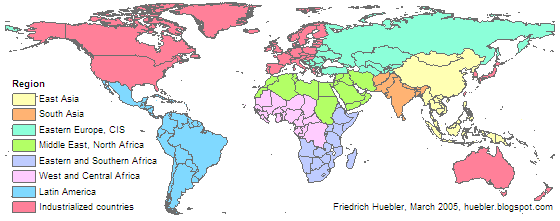The
Millennium Development Goals do not require that all children attend secondary school, instead they only ask for gender parity at the secondary level by the year 2015. Nevertheless, participation in secondary education is an important indicator because at this level children acquire more specialized knowledge than in primary school, which enables them to be more competitive in the labor market than their less educated peers.
The
Global Education Digest 2005 contains the latest data on secondary school enrollment, for the 2002/03 school year. The secondary school net enrollment ratio (NER) - the share of children of secondary school age that are currently enrolled in secondary school - is known for fewer countries than the
primary school NER. No data on secondary school enrollment is available for China, Russia, virtually all of South Asia, and many countries in the Middle East and Africa (see the map below). Overall, the
Global Education Digest lists the secondary school NER for 165 countries while the primary school NER is provided for 181 countries.
Secondary school net enrollment ratio, 2002/2003 Data source: UNESCO Institute for Statistics (UIS). 2005. Global Education Digest 2005. Montreal: UIS.
Data source: UNESCO Institute for Statistics (UIS). 2005. Global Education Digest 2005. Montreal: UIS.In spite of the lack of data, it is possible to compare individual regions. For this purpose I adopt the regions used by UNICEF, shown in the following map.
UNICEF regions Source: UNICEF website, March 2005.At the global level, 59% of all children of secondary school age, boys as well as girls, were enrolled in secondary school. The secondary school NER is highest among industrialized countries (91%) and in the Eastern Europe/CIS region (82%). Three regions are around the global average: Latin America and the Caribbean (67%), Middle East and North Africa (58%), and East Asia and the Pacific (54%).
Source: UNICEF website, March 2005.At the global level, 59% of all children of secondary school age, boys as well as girls, were enrolled in secondary school. The secondary school NER is highest among industrialized countries (91%) and in the Eastern Europe/CIS region (82%). Three regions are around the global average: Latin America and the Caribbean (67%), Middle East and North Africa (58%), and East Asia and the Pacific (54%).
Secondary school enrollment is lowest in Eastern and Southern Africa (23%), West and Central Africa (25%), and South Asia (45%; note that this average is based on two countries only: Bangladesh and the Maldives).
Secondary school net enrollment ratio, 2002/03| Region | Secondary school NER (%)
|
| Male | Female | Total |
| East Asia, Pacific | 51.1 | 52.0 | 54.4 |
| Eastern and Southern Africa | 24.5 | 21.8 | 23.2 |
| Eastern Europe, CIS | 82.2 | 81.8 | 82.0 |
| Industrialized countries | 90.5 | 91.9 | 91.2 |
| Latin America, Caribbean | 64.7 | 69.0 | 66.8 |
| Middle East, North Africa | 60.9 | 55.6 | 58.3 |
| South Asia | 42.2* | 46.9* | 44.5* |
| West and Central Africa | 28.2 | 20.9 | 24.7 |
| World | 59.1 | 59.0 | 59.3 |
Data source: UNESCO Institute for Statistics (UIS). 2005. Global Education Digest 2005. Montreal: UIS.
Notes: (1) Regional values are weighted by each country's population of secondary school age. - (2) The male and female NER is available for fewer countries than total NER. This explains why the total NER is greater than the male and female NER in East Asia and at the global level. - * Sample size too small to be representative for region.At the
primary level, girls' NER is usually below that of boys but this is not true at the secondary level. In two regions - Latin America and South Asia - girls are more likely to be enrolled in secondary school than boys. In three regions - Eastern and Southern Africa, West and Central Africa, and the Middle East and North Africa - boys are more likely to be in secondary school. The remaining three regions - East Asia and the Pacific, Eastern Europe/CIS, and the industrialized countries - are close to the Millennium Development Goal of gender parity in secondary education.
Friedrich Huebler, 1 June 2005 (edited 16 July 2005), Creative Commons License

